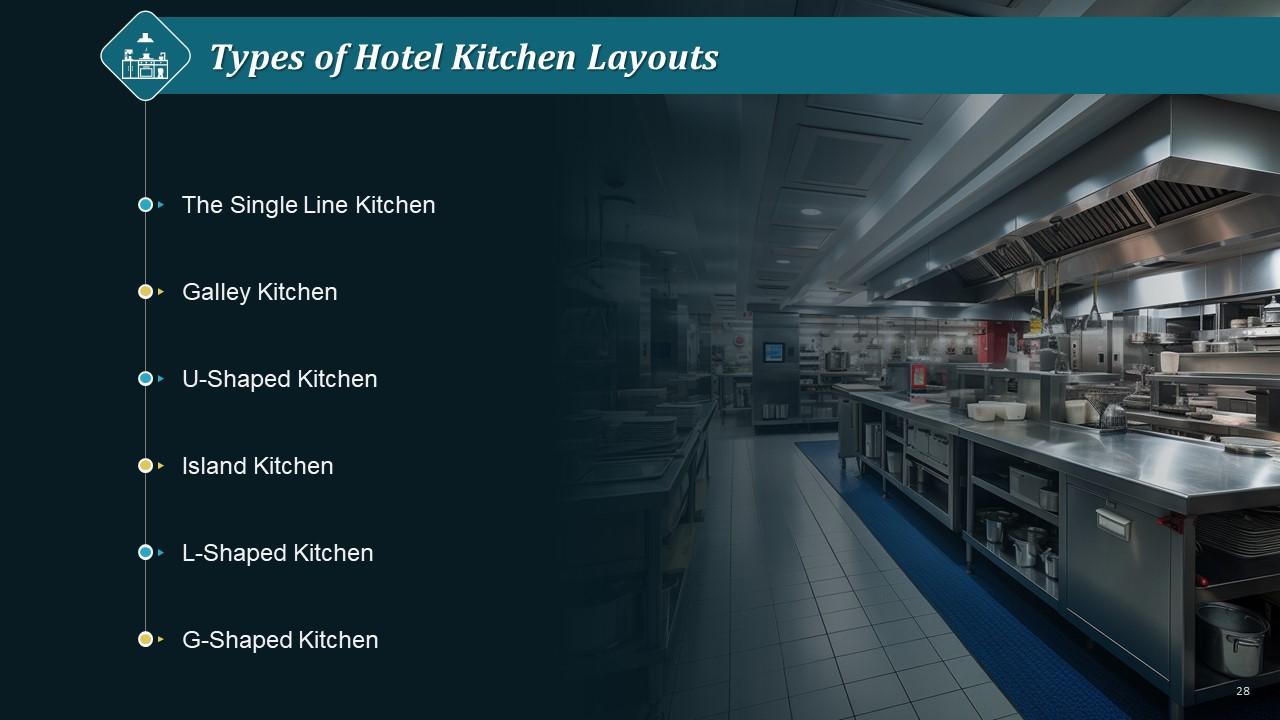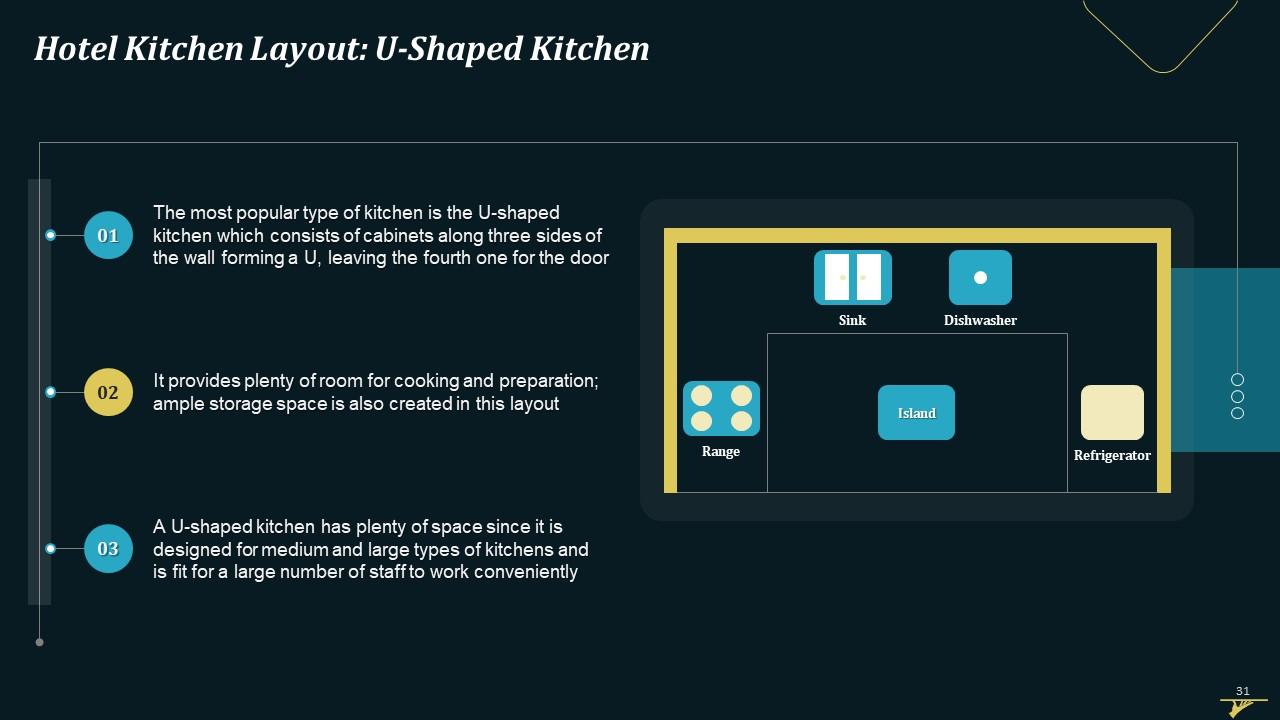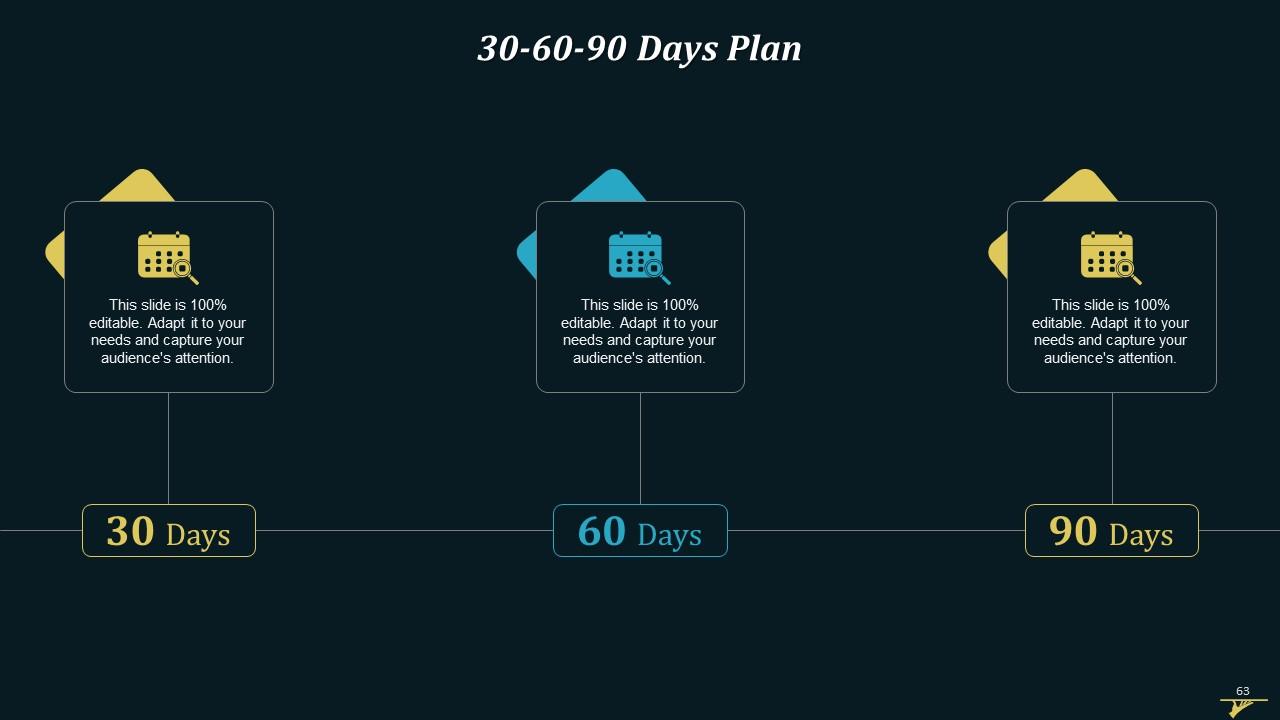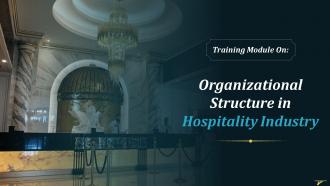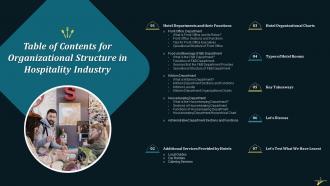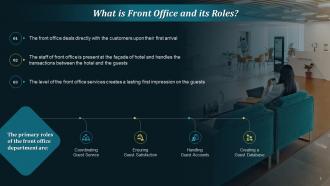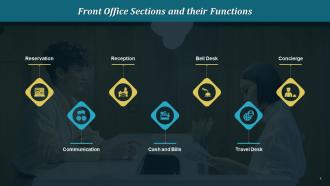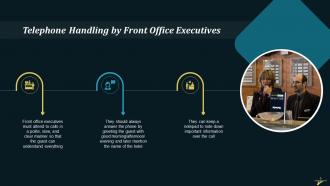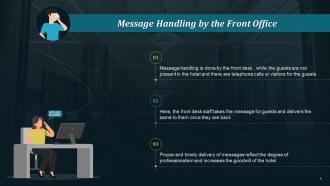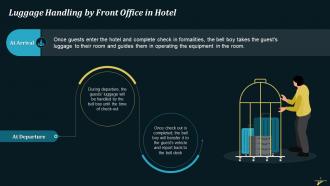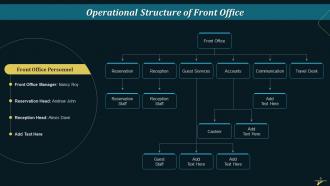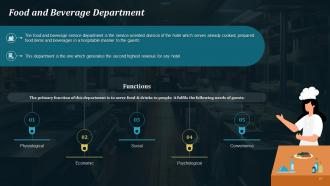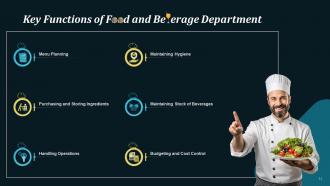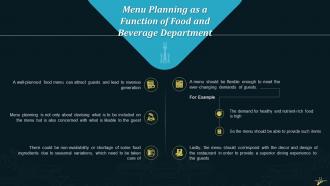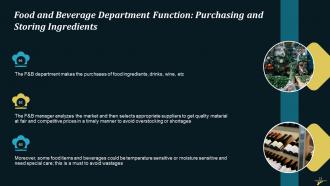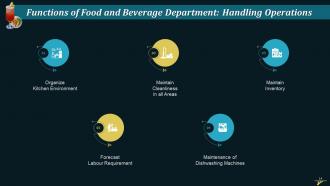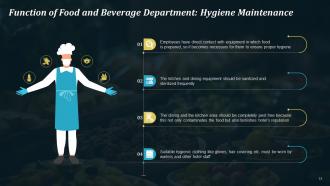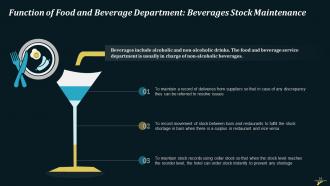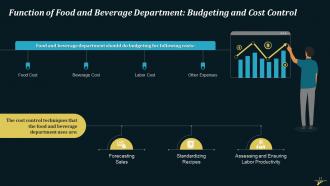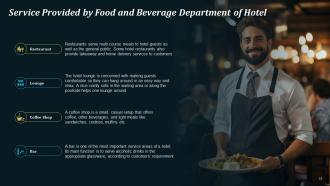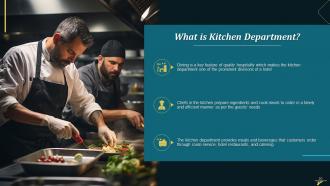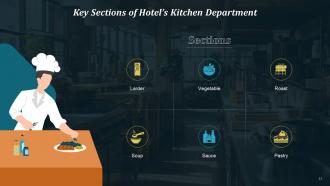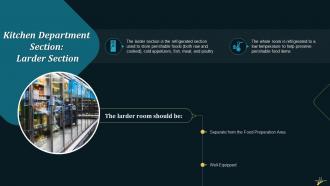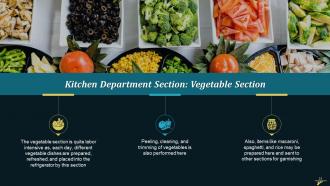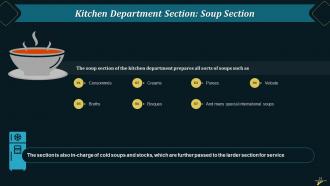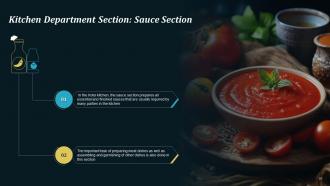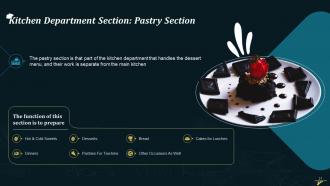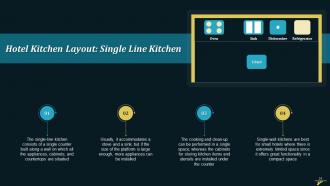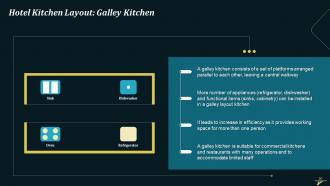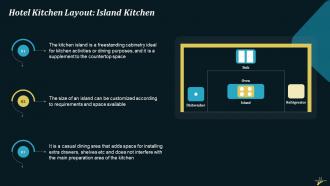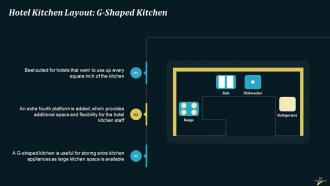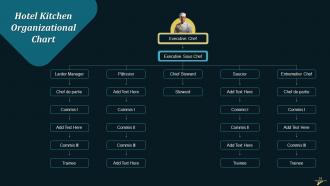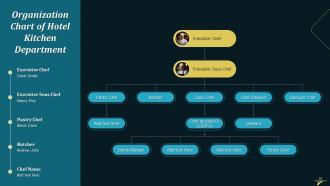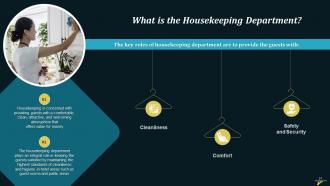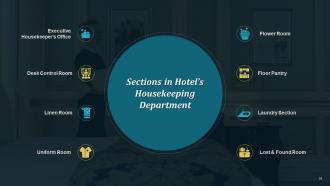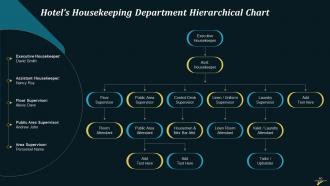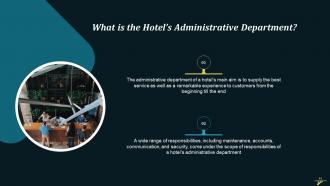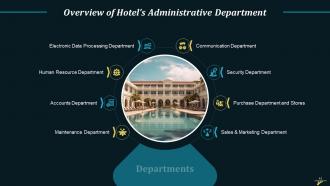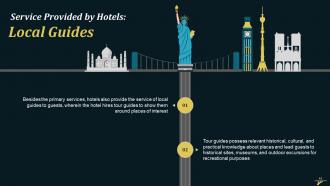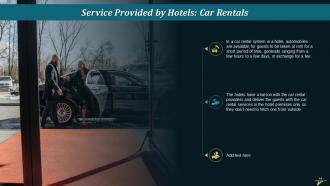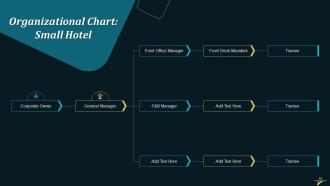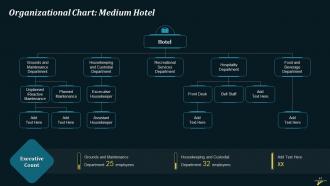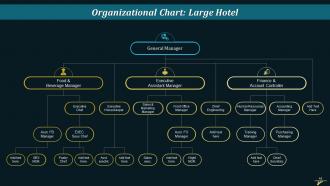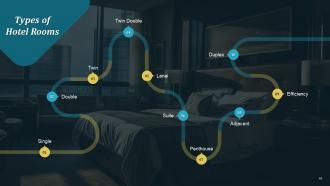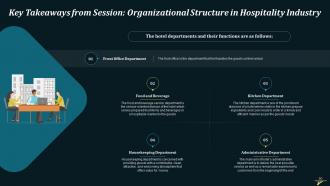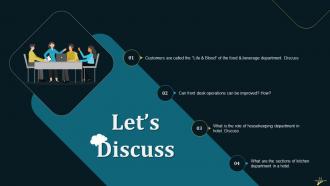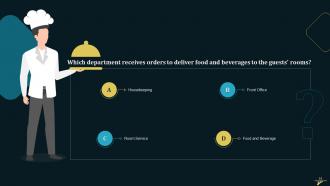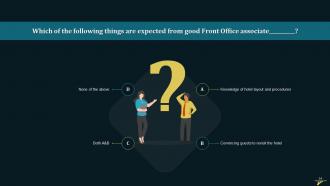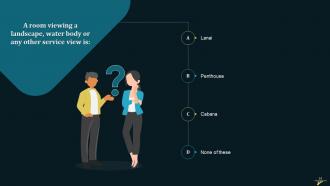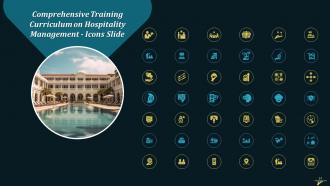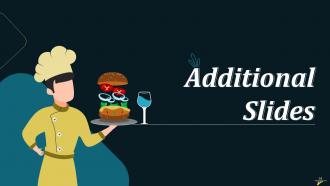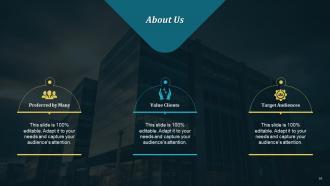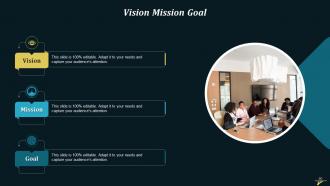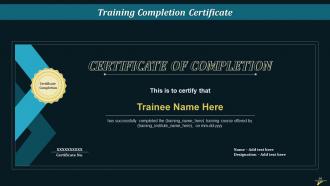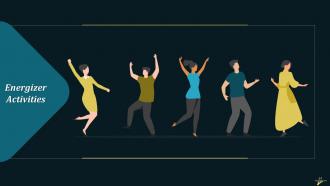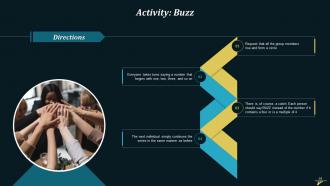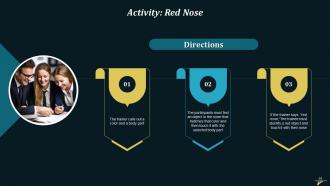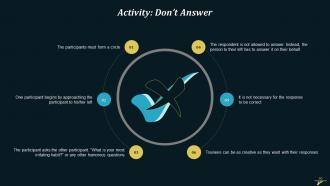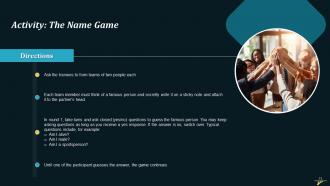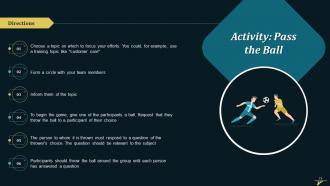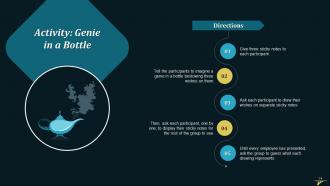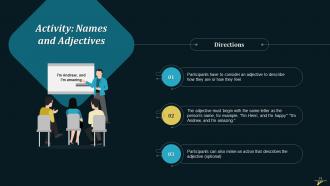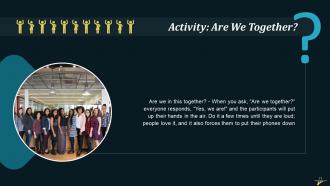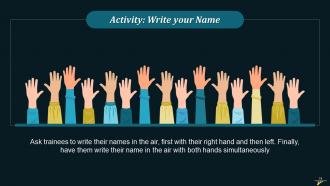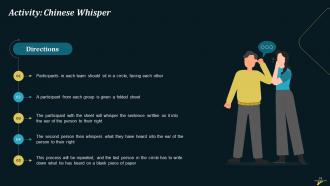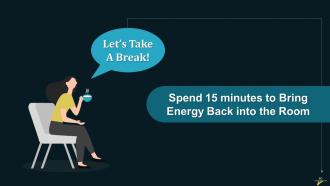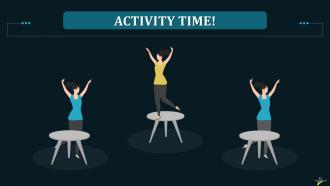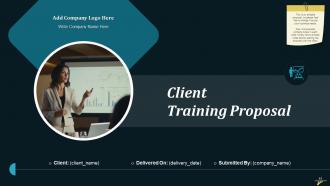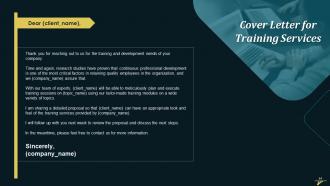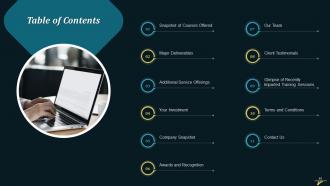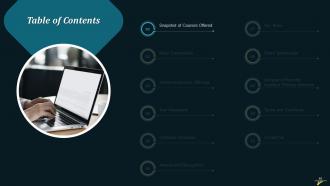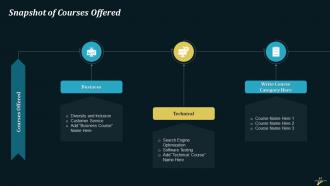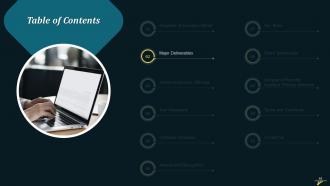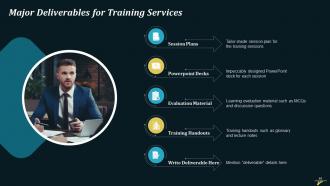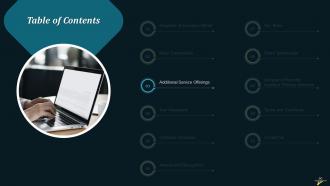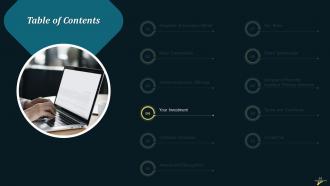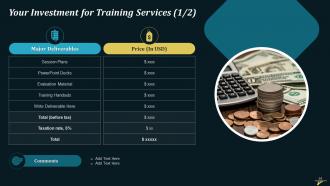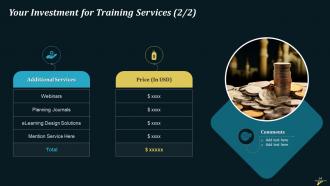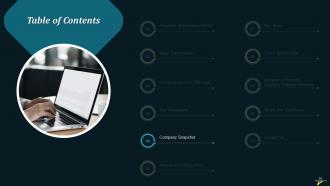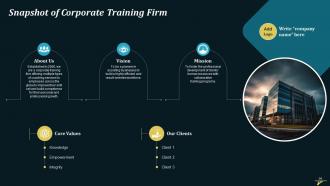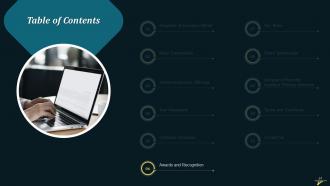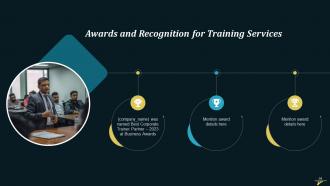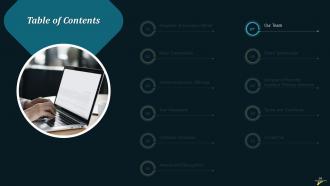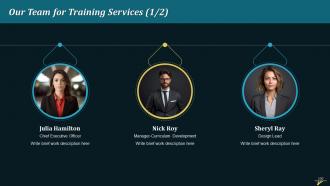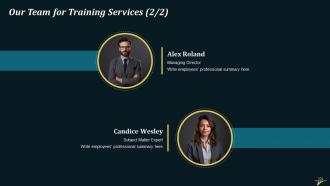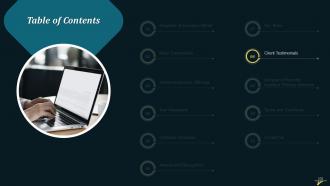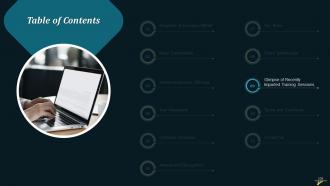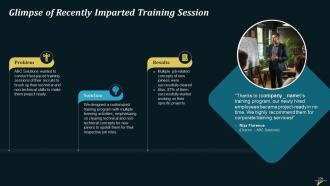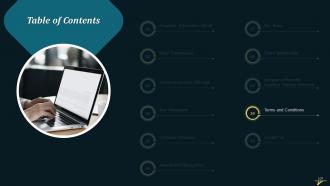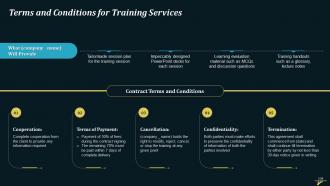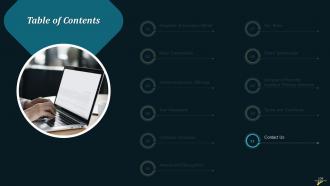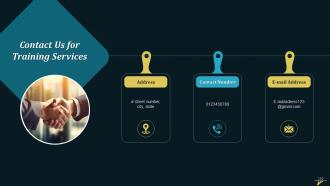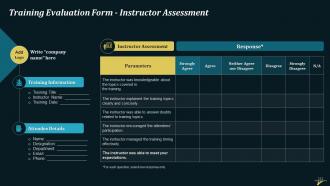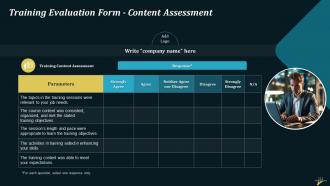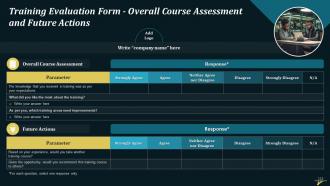Organizational Structure In Hospitality Industry Training Ppt
This PPT Training Module on Organizational Structure in Hospitality Industry, delves into the pivotal hotel departments - Front Office, Food and Beverage F and B, Kitchen, and Housekeeping - elucidating their roles, functions, and operational structures. The module explores each departments responsibilities through detailed sections, from the initial guest contact at the Front Office to the behind-the-scenes action in the Kitchen, and the essential upkeep carried out by Housekeeping. It also highlights the Administrative Departments role and introduces additional services that enhance guest experiences, such as local guides, car rentals, and catering. Complete with organizational charts for clarity, insights into different types of hotel rooms, and ending with thought-provoking Discussion Questions and Key Takeaways, this PowerPoint Deck is designed to provide a thorough overview of how various segments synergize to define the hospitality industrys backbone.
You must be logged in to download this presentation.
PowerPoint presentation slides
Presenting Training Deck on Organizational Structure in Hospitality Industry. This deck comprises of 55 slides. Each slide is well crafted and designed by our PowerPoint experts. This PPT presentation is thoroughly researched by the experts, and every slide consists of appropriate content. All slides are customizable. You can add or delete the content as per your need. Not just this, you can also make the required changes in the charts and graphs. Download this professionally designed business presentation, add your content and present it with confidence.
People who downloaded this PowerPoint presentation also viewed the following :
Content of this Powerpoint Presentation
Slide 3
This slide contains information about the definition and roles of front office in hotel which are coordinating guest service, ensuring guest satisfaction, handling guest accounts, and creating a guest database.
Slide 4
This slide highlights the sections and the functions of front office, which are reservations, reception, bell desk, concierge, communication, cash and bills and travel desk.
Instructor’s Notes:
The functions of front office departments in a hotel are:
- Reservations: The reservation section books rooms for guests in advance. It performs the functions of receiving guests’ requests from sources like email, websites, and telephone and then processing those requests. It also maintains and updates the guests’ records to provide timely and accurate information
- Reception: Reception is located at the façade of hotel and is responsible for receiving and welcoming guests as soon as they arrive. It also completes the registration formality and assigns rooms to the guests
- Bell Desk: This section performs the function of handling guests' luggage during arrival and departure and making general purchases like medicines for them
- Concierge: Concierge section provides personalized services to guests like making reservations in restaurants, arranging special transport, and procurement of tickets to special events
- Communication: Answering incoming calls, charging outgoing calls to guest accounts, and directing calls to guest rooms are the key functions of the communication section of a hotel
- Cash and Bills: The cash and bills section record financial details of the guest. Maintaining guest accounts, preparing bills during checkout, handling payments through debit and credit cards, and organizing foreign currency exchange are the main functions of this section
- Travel Desk: Arranging pick and drop services for guests, organizing sightseeing activities and arranging guides and translators are key roles of the travel desk
Slide 5
This slide showcases how telephone handling has to be done in the hotel. It has to be done in a polite, slow, and clear manner so that the guest can understand everything properly and a notepad could be kept to note down important information.
Slide 6
This slide contains information about message handling in hotel. Here, the front desk staff takes the message for guests and delivers it to them once they return.
Slide 7
This slide highlights the luggage handling by front office in the hotel at the time of arrival and during departure by bell boy in the hotel.
Slide 8
This slide showcases how the front office staff should handle the situation if there is a theft, fire, death or a bomb threat at the hotel.
Instructor’s Notes:
Here are the best-practices/responses for each of these situations:
- Theft: It is important that security features such as automatic closing doors, peepholes, etc. are present. Information about the guest's room number or handing over the keys of guests' rooms to any unauthorized person must be avoided at all costs. Professional hotel security staff could be employed who would be extra vigilant
- Fire: The critical first response is to inform the firefighting department by giving exact details about the location and size of the hotel. Then, all guests should be quickly and safely evacuated while prioritizing the safety of old and disabled guests
- Death: After receiving information about a guest's death, the front office staff should inform the general manager and call the hotel doctor and the police. The hotel staff should seal the room till all police formalities are over, and the kin of the deceased should be contacted
- Bomb Threat: Raise immediate alarm and call security. Then, announcements should be made and evacuation of the hotel has to be carried out
Slide 9
This slide contains information about the sections under front office which could be reservation, reception, guest services, accounts, communication and travel desk.
Slide 10
This slide contains information about the food and beverage department in a hotel. This department serves prepared food items and beverages in a hospitable manner to guests and meets their physiological, economic, social, psychological and convenience needs.
Instructor’s Notes:
The functions of food and beverage service department are:
- Physiological: The need for unique food items
- Economic: Offers good value
- Social: A friendly and open atmosphere
- Psychological: Satisfies guests’ need to enhance self‐esteem
- Convenience: Being able to relish food while someone else serves it
Slide 11
This slide contains information about the major functions of food and beverage department which are menu planning, purchasing and storing ingredients, handling operations, hygiene maintenance, beverages stock maintenance and budgeting and cost control.
Slide 12
This slide highlights how the menu should be prepared by the food and beverage department while keeping in mind aspects like customer demand and flexibility. Also, it should correspond with the décor and design of the restaurant to provide superior dining experience to guests.
Slide 13
This slide showcases the function of F&B department which is to order the right quantity of ingredients, food, and drinks. Also, some food items and beverages could be temperature sensitive or moisture sensitive and need special care; the department needs to ensure this is done to avoid wastage
Slide 14
This slide contains information about F&B department’s operation handling function. The department organizes kitchen environment, maintains cleanliness in all areas, records and take care of inventory, forecasts labor requirement, and maintains dishwashing machines.
Instructor’s Notes:
Operations that the F&B department handles ae:
- Organize Kitchen Environment: A well-organized and planned layout ensures that kitchen staff’s needs are available at hand and they are not running around searching for things. It improves their efficiency so they can provide the best and timely services to guests
- Maintain Cleanliness in all Areas: It is the duty of the F&B staff to ensure the cleanliness of glassware, cutlery and the inventory. Sanitation and pest control could also be carried out for providing a clean environment in the kitchen and inventory
- Maintain Inventory: An inventory log should be maintained where stock items are recorded on a daily and monthly basis. The F&B manager will be able to ascertain food costs, plan food orders accordingly, and make changes by tracking and recording inventory
- Forecast Labor Requirement: An appropriate level of labor will give the maximum yield in the food and beverages department. Whereas high labor count will lead to huge costs, low labor count will lead to loss of efficiency and productivity. The F&B manager has to carefully ascertain the labor requirement from time to time according to hotel needs
- Maintenance of Dishwashing Machines: If there are piled up dirty utensils and dishes, there will be no clean containers for preparation of food. Out-of-service machines will hinder for the smooth functioning of the F&B department
Slide 15
This slide highlights hygiene maintenance as an essential function of F&B department. It highlights that the kitchen and dining equipment should be sanitized and sterilized post every cleaning, and the area should be completely pest-free. Suitable hygienic clothing like gloves, hair covering etc. must be worn by waiters and other hotel staff.
Slide 16
This slide contains information about beverage control by the F&B department and the factors needed to be considered while managing the bar and beverage. The food and beverage service department is usually in charge of non-alcoholic beverages.
Slide 17
This slide explains about the F&B managers’ responsibility of budgeting and cost control. The costs associated with F&B department are: food cost, beverage cost, and labor cost. The multiple cost control techniques deployed are forecasting sales, standardizing recipes, and assessing and ensuring labor productivity.
Instructor’s Notes:
Food and beverage department should do budgeting for following costs:
- Food Cost: It includes costs incurred while preparing the food. The plate cost, cost of raw materials used, and the cost of non-alcoholic beverages come under its purview
- Beverage Cost: The relates to alcoholic beverages served in the restaurant and bar
- Labor Cost: Labor cost comprises expenses incurred in retaining the restaurant staff and the taxes incurred on the payrolls of the employees
- Other Expenses: These include other costs that are incurred while running a restaurant, such as utilities, rent, kitchen equipment, etc.
The cost control techniques deployed by F&B department are as follows:
- Forecasting Sales: Forecasting refers to ascertaining the demand for food and beverages before making purchases for it. It leads to saving on labor cost and raw material cost
- Standardizing Recipes: Standardizing recipes gives a set measure of the amount of ingredients to be used, the number of servings, and the set portions for each meal which minimizes the cost. Also, it helps in maintaining consistency across multiple orders and outlets.
- Assessing and Ensuring Labor Productivity: Hiring suitable staff for F&B department and providing them trainings is essential as it ensures high productivity. Furthermore, productivity and cost inefficiencies can be ruled out by putting the correct number of employees on a particular job
Slide 18
This slide contains information about the other services provided by F&B department of a hotel which are restaurants, lounge, coffee shop and bar.
Slide 19
This slide represents the sub-departmental heads under the food and beverage manager. These could be room service head, bar head, banquet head, restaurant head and so on.
Slide 20
This slide highlights the function of kitchen department in hotel industry which is to prepare ingredients and cook meals to order in a timely and efficient manner as per the guests' needs. It provides meals and beverages that customers order through room service, hotel restaurants, and catering.
Slide 21
This slide highlights the sections of hotel’s kitchen department which are larder section, vegetable section, roast section, soup section, sauce section, and pastry section.
Slide 22
This slide contains information about the larder section in the hotel kitchen department. This is the refrigerated section used to store perishable foods (both raw and cooked), cold appetizers, fish, meat, and poultry.
Instructor’s Notes:
The larder room should be:
Separate from the Food Preparation Area: The larder room should be separate from the main kitchen where food is prepared. It is important so as to protect food from being spoiled by the heat of kitchen
Well-Equipped: Mincing and Slicing machines, refrigerators, and other equipment are required in the larder section. This makes it essential for the room to be well-equipped with power and lighting
Slide 23
This slide contains information about the role of vegetable section in the kitchen department. This section is quite labor intensive as, each day, various quantities of vegetable dishes are prepared, refreshed, and placed into the refrigerator by this section
Slide 24
This slide represents the role of roast section in the kitchen department. It is delegated with the role of grilling dishes of meat, chicken, and fish. Likewise, deep frying and finishing of dishes is also done here
Slide 25
This slide highlights the functions of soup section in the kitchen department which is to prepare all sorts of soups such as creams, purees, broths, and many other international soups.
Slide 26
This slide showcases the function of sauce section in the kitchen department. All the meat dishes are cooked and garnished in this section. Also, it provides all essential and finished sauces, that are usually required by the parties in the kitchen.
Slide 27
This slide showcases the role of pastry section in the kitchen department which is to prepare hot & cold sweets, desserts, bread, and cakes for lunches, dinners, and pastries for tea-time and other occasions as well.
Slide 28
This slide highlights the types of kitchen layouts which could be used to design a hotel kitchen which are the single line kitchen. The types are: galley kitchen, U-shaped kitchen, island kitchen, L-shaped kitchen and G-shaped kitchen.
Instructor’s Notes:
The types of kitchen layouts are as follows:
- The Single Line Kitchen: Single line kitchen is a simple space-efficient layout that keeps all the cabinets and appliances against one wall without compromising on functionality and convenience
- Galley Kitchen: Galley kitchen makes use of every millimeter of space without any wastage. It is shaped in a manner where two cabinets face each other, creating an inner pathway or galley between them
- U-Shaped Kitchen: A U-Shaped kitchen is suitable for larger kitchens, with cabinets built along three adjacent walls. It allows for great workflow and multiple users at the same time
- Island Kitchen: A large working area or storage area is provided in the middle of an island kitchen where a cooking surface or a bar or wine fridge could be installed
- L-Shaped Kitchen: A practical layout option for both large and small kitchens, it has cabinets along two perpendicular walls. Another plus point is that it offers great flexibility in the placement of appliances
- G-Shaped Kitchen: G-shaped kitchens resemble the letter 'G.' It is quite similar to U-shaped kitchens except for the fact that it has a fourth dimension that creates additional space for work
Slide 29
This slide contains information about the layout of single line hotel kitchen. It consists of a single counter built along a wall on which all the appliances, cabinets, and countertops are situated. The cooking and clean-up can be performed in a single space, whereas the cabinets for storing kitchen items and utensils are installed under the counter.
Slide 30
This slide highlights the layout of galley hotel kitchen. In galley kitchen, a set of platforms are arranged parallel to each other, leaving a central walkway. It is suitable for commercial kitchens and restaurants with many operations and to accommodate limited staff.
Slide 31
This slide showcases the features of a U-Shaped hotel kitchen layout. It is the most popular type of kitchen format as it consists of cabinets along three sides of the wall forming a U, leaving the fourth one for the door.
Slide 32
This slide contains information about layout of island kitchen. It is a freestanding cabinetry ideal for kitchen activities or dining purposes whose size can be customized according to requirements and space available. It also adds space for installing extra drawers, shelves etc. and does not interfere with the main preparation area of the kitchen.
Slide 33
This slide depicts the L-Shaped kitchen layout which permits cabinets and appliances to be installed along right angled walls with an open area in the center. It is best suited for open plan designs where guests can observe the activity in the kitchen. It also facilitates optimum use of the corner space.
Slide 34
This slide highlights about the G-Shaped hotel kitchen layout. It is best suited for those who want to use up every square inch of the kitchen. An extra fourth platform is added, which provides additional space and flexibility for the user. And, it is useful for storing extra kitchen appliances since there is availability of large kitchen space.
Slide 35
This slide showcases the hierarchical chart in the kitchen department of a hotel. An Executive Chef heads this department
Slide 36
This slide represents the organization chart of kitchen department in a hotel. It also contains information about chef’s names.
Slide 37
This slide provides an overview of housekeeping department in hotel. The housekeeping department plays an integral role in keeping the guests satisfied by maintaining the highest standards of cleanliness and hygiene in guest rooms and public areas.
Instructor’s Notes:
The key roles of housekeeping department in a hotel are:
- Cleanliness: The housekeeping department of a hotel is liable for cleanliness by removing waste materials, keeping work areas neat and orderly, and maintaining halls and floors
- Comfort: The ultimate priority of the hotel's housekeeping department is to establish a comfortable and soothing environment for the guests
- Safety and Security: The safety and security of guests, and the staff, are ensured by ensuring safe conditions and best practices on hygiene in the hotel
Slide 38
This slide contains information about the sections under housekeeping department. These are executive housekeeper’s office, desk control room, linen room, uniform room, flower room, floor pantry, laundry section and lost and found room.
Instructor’s Notes:
The sections in hotel’s housekeeping department are:
- Executive Housekeeper's Office: The executive housekeeper has to counsel, plan and delegate tasks to subordinates which is why the housekeeper’s office should be glass paneled, thus providing him/her a view of outside operations
- Desk Control Room: The desk control room is where staff reports at the start and end of their duty. All coordination and communication take place in the desk control room. Usually, it also has a notice board to pin up staff schedules and daily instructions
- Linen Room: The linen room stores the current linens for issue and receipt. The linen room should be airy, free from heat and humidity, have adequate shelves, and a counter for the exchange of linen
- Uniform Room: The main function of the uniform room is to store, provide and distribute staff uniforms along with providing adequate hanging facilities for uniforms
- Flower Room: Flower room is an air-conditioned room to keep flowers fresh for longer durations. It caters to all sorts of flower arrangements the hotel may require
- Floor Pantry: Situated away from the guest's view, the floor pantry differs for each floor. It contains shelves, cupboards, and a maid's trolley to assemble food trays at meal times
- Laundry Section: The laundry section provides ironing and dry-cleaning services for hotel guests, staff's uniform, F&B linen, and guest room linen along with stitching and repairing of uniform and linen
- Lost & Found Room: The lost and found room stores all guest items that are lost and may be claimed later
Slide 39
This slide highlights functions of housekeeping department in hotel. These are cleaning rooms and public area, bed making, clothing and linen management, laundry services, key control, pest control, interior decoration, and room maintenance.
Instructor’s Notes:
The functions of housekeeping department in hotel are:
- Cleaning Rooms and Public Area: The housekeeping staff should maintain cleanliness and hygiene of hotel property as standard of a hotel is reflected in clean floors, lobby, dining rooms, store room, bars, etc.
- Bed Making: It is the duty of the housekeeping department to ensure that the lean sheets, blankets, pillows, bottom sheets, night sheets, etc., are set in a proper manner. A skilled housekeeping personnel should be able to make a neat bed within minutes
- Clothing and Linen Management: In hotels, curtains, cushion covers, pillow covers, bed sheets, etc. are included in linen. Efficient linen and laundry management requires proper wash and treatment of soiled clothing so that they look and smell fresh
- Laundry Services: The housekeeping department ensures proper cleaning and hygienic washing of all linen items and a continuous supply of linen to departments
- Key Control: The housekeeping staff securely handles keys before and after allocating the room to guests
- Pest Control: There is always high risk of the presence of bedbugs, rats, mice, cockroaches and other insects that can damage the hotel’s reputation, thus pest control is an important part of housekeeping department's responsibility
- Interior Decoration: Interior decoration is concerned with aesthetically designing and planning a room and creating a pleasant atmosphere by adding art and craft. and it is done by housekeeping department in a hotel
- Room Maintenance: All damaged and broken items such as broken furniture, squeaking doors, pipe leakages etc. in hotel’s rooms have to be given special attention. The housekeeping department works in liaison with the maintenance department and makes sure all rooms are perfectly maintained and are in pristine condition
Slide 40
This slide highlights positions in hotel’s housekeeping department which are floor supervisor, public area supervisor, control desk supervisor, linen supervisor, laundry supervisor etc.
Slide 41
This slide contains information about the administrative department of a hotel. Its main aim is to supply the best service as well as a remarkable experience to customers from the beginning till the end. A wide range of responsibilities including maintenance, accounts, communication, and security, come under the scope of responsibilities of a hotel’s administrative department
Slide 42
This slide provides an overview of multiple sub-sections of hotel’s administrative department. These are maintenance, accounts, human resource, and electronic data processing departments. Other significant departments are communication, security, purchase, stores and a sales and marketing department
Instructor’s Notes:
The sub-departments under a hotel’s administrative department are:
- Maintenance Department: The maintenance department is liable for smooth working of water, electricity, and air conditioning unit of hotel. It is responsible for fixing broken furniture, window panes and doors
- Accounts Department: The accounts department of a hotel looks after the multiple finance related tasks such as allocation of budget, preparation of balance sheet of company, salary distribution to employees, and tax filing
- Human Resource Department: The human resource (HR) department in a hotel is assigned with the task of recruitment, selection, and training of personnel along with maintenance of attendance and leave records of employees
- Electronic Data Processing Department: Maintenance of elements of the Internet, computer and their related matters, and generation of relevant electronic data for the hotel comes under the scope of electronic data processing department
- Communication Department: The communication department is in charge of upkeep of telephone and cable connections of each hotel room. It is also responsible for audio-visual equipment for conferences and party halls of the hotel
- Security Department: The security department is responsible for the safety and security of guests and employees of the hotel. This department also keeps the record of received and dispatched materials, and movement of fixed assets of property
- Purchase Department and Stores: The role of purchase and stores department is the purchase of materials and equipment from market as per requirement, liaising with dealers and vendors for supply of goods and issuing materials to departments
- Sales & Marketing Department: The sales and marketing department performs the task of retaining and enhancing the brand image of the hotel. They also act as an agent between the hotel and the guest/clients to up-sell and cross-sell hotel services
Slide 43
This slide highlights the service of local guides that a hotel offers. In this, the hotel hires tour guides to show them around places of interest such as historical sites, museums, and outdoor excursions for recreational purposes.
Slide 44
This slide contains information about the car rental service in a hotel. Here, automobiles are available for guests to be taken at rent for a short period of time, generally ranging from a few hours to a few days, in exchange for a fee.
Slide 45
This slide contains details about the catering services that a hotel provides. The outside catering service is provided by the hotels wherein it extends food, beverage, staff services for events, conferences, marriages, exhibitions, or other functions.
Slide 46
This slide showcases the organizational chart for a small hotel having up to 100 rooms which could be divided into front office manager, food and beverages manager and so on.
Slide 47
This slide highlights the organizational chart for a medium sized hotel. The departments under it could be grounds and maintenance department, housekeeping and custodial department, hospitality department etc.
Slide 48
This slide showcases the organizational departments under a large hotel. These could be food and beverage manager, executive assistant manager, finance and account controller and so on.
Slide 49
This slide illustrates various types of rooms at a hotel. These can be single, double, twin, twin double, lanai, suite, penthouse, adjacent, efficiency, and duplex.
Instructor’s Notes:
The types of rooms in hotel are:
- Single: A room containing a single bed meant for one person
- Double: A double bed room for two persons
- Twin: It has two single beds to be used by two persons
- Twin Double: A twin double room has two double beds meant for families
- Lanai: It has a good view of a garden or a scenic beauty and is generally available in resort hotels
- Suite: A suite is an expensive room containing extra facilities like expensive furniture, complimentary food items etc. It also has a drawing room unlike regular rooms
- Penthouse: This kind of room has an open view of the sky. It consists of a set of rooms located at the topmost level of the hotel
- Adjacent: Adjacent rooms are the ones having two rooms with connecting doors. These can be accessed without going through the hotel corridor
- Efficiency: These rooms have kitchen facilities attached to them and are suitable for guests who stay for a long period (1-2 weeks or more)
- Duplex: This type of room has two separate levels connected by a staircase. Normally, the drawing room is at the lower level, and bedroom is at the upper level
Slide 50
This slide highlights the key takeaways from the session on hotel structure and functions. The trainer can use this slide to highlight essential learnings from the session to trainees.
Slide 67 to 82
These slides contain energizer activities to engage the audience of the training session.
Slide 83 to 110
These slides contain a training proposal covering what the company providing corporate training can accomplish for the client.
Slide 111 to 113
These slides include a training evaluation form for instructor, content and course assessment.
Organizational Structure In Hospitality Industry Training Ppt with all 122 slides:
Use our Organizational Structure In Hospitality Industry Training Ppt to effectively help you save your valuable time. They are readymade to fit into any presentation structure.
-
Placing an order on SlideTeam is very simple and convenient, saves you a lot of your time.
-
This visual representation is stunning and easy to understand. I like how organized it is and informative it is.





























